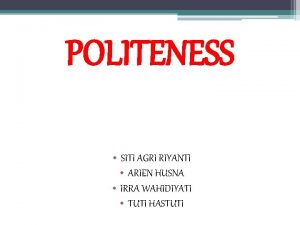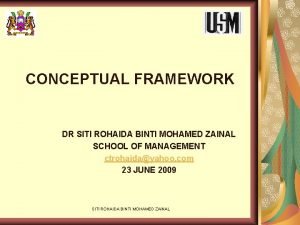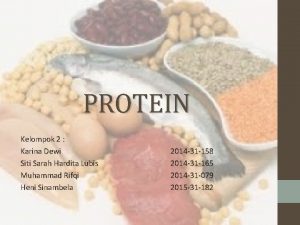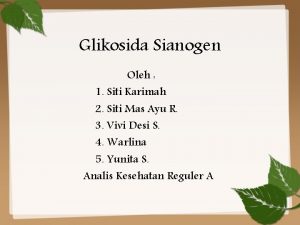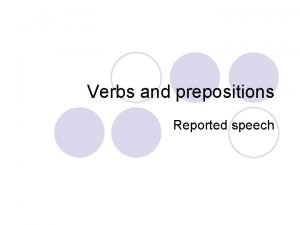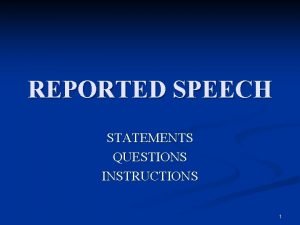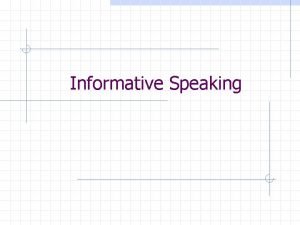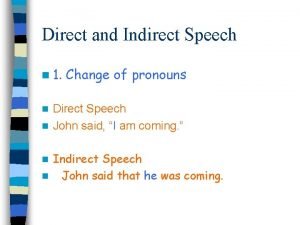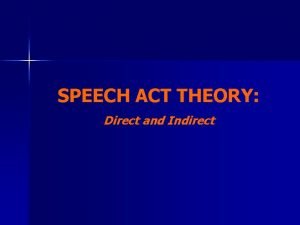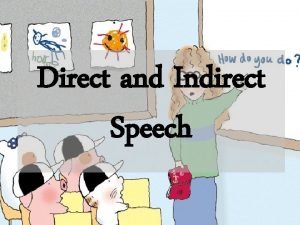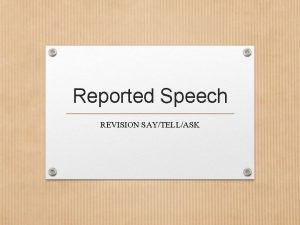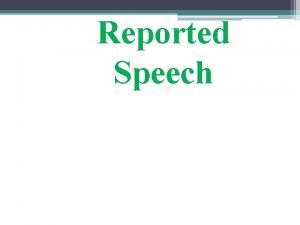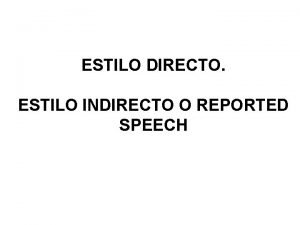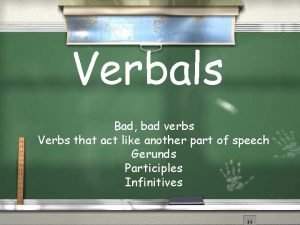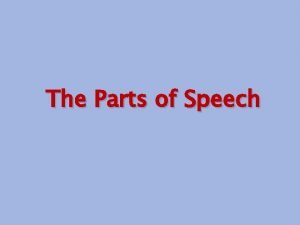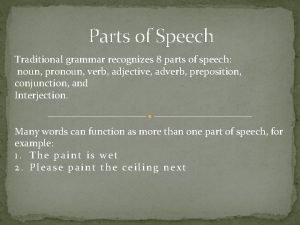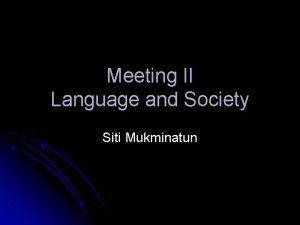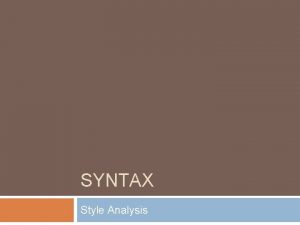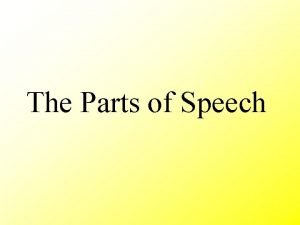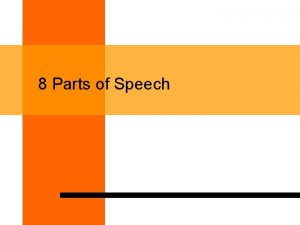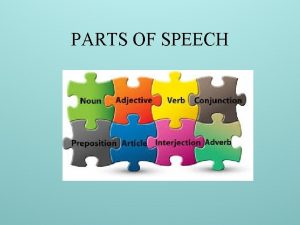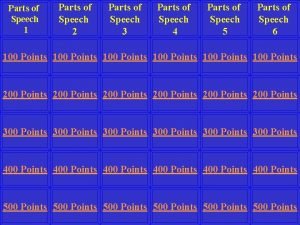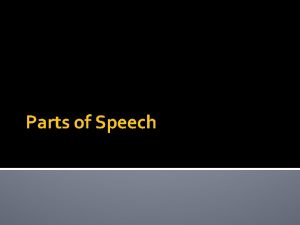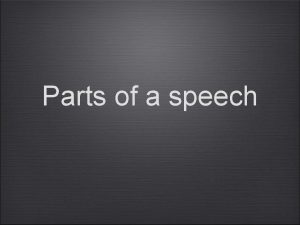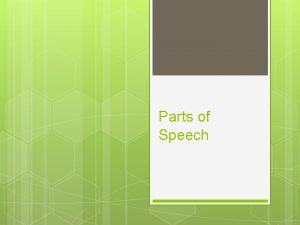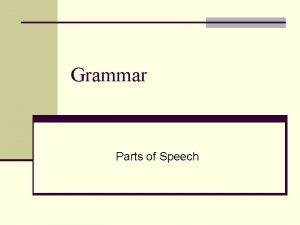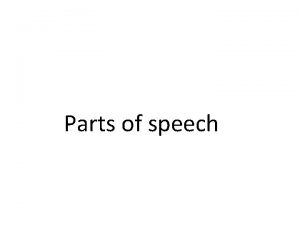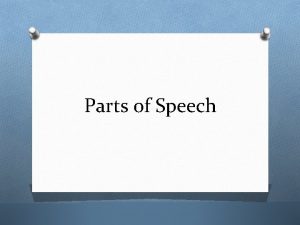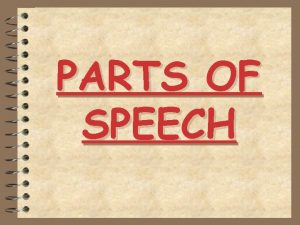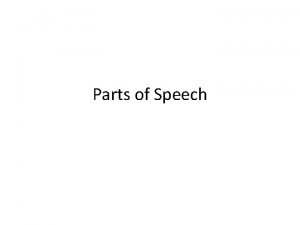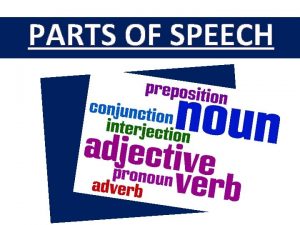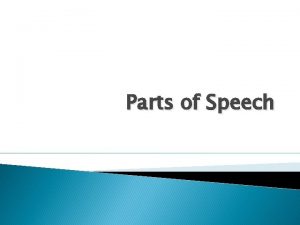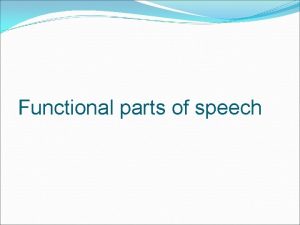Meeting 2 Syntax Parts of Speech Siti Mukminatun














































![Subcategories of verb Subcategory V [NP_ ] (intransitive) V [NP_NP] (transitive type 1) V Subcategories of verb Subcategory V [NP_ ] (intransitive) V [NP_NP] (transitive type 1) V](https://slidetodoc.com/presentation_image/10b171a234304f82afea2aa9dd2974de/image-47.jpg)

- Slides: 48

Meeting 2 Syntax Parts of Speech Siti Mukminatun

What is syntax? n n The part of the grammar that represents a speaker’s knowledge of sentences and their structure Structure= Word order The meaning of a sentence depends largely on the order in which words occur in a sentence. e. g. She has what a man wants. ≠ she wants what a man has.

What is syntax? ● However, a change of word order has no effect on meaning. e. g. The chief Justice swore in the new Presidents. The chief Justice swore the new President in. ● The grammars of all languages include rules of syntax that reflects speakers’ knowledge of these facts.

Grammatical or ungrammatical Sequences of words that conform to the rules of syntax are well formed or grammatical n Those that violate the syntactic rules are ill formed or ungrammatical n

What grammaticality is based on? n Use your knowledge of English and place an asterisk in front of the ones that strike you as peculiar or funny in some way. 1. (a) The boy found the ball. (b) The boy found quickly. (c) The boy found in the house (d) The boy found the ball in the house. 2. (e) Disa slept the baby. (f) Disa slept soundly.

3 (g) Zack believes Roberts to be a gentleman. (h) Zack believes to be a gentleman. (i) Zack tries Robert to be a gentleman. (j) Zack tries to be a gentleman. (k) Zack wants to be a gentleman. (l) Zack wants Roberts to be a gentleman. 4. (m) Jack and Jill ran up the hill. (n) Jack and Jill ran up the bill (o) Jack and Jill ran the hill up. (p) Jack and Jill ran the bill up. (q) Up the hill ran Jack and Jill. (r) Up the bill ran Jack and Jill.

What grammaticality is based on? n The syntactic rules that account for the ability to make these judgments include other constraints in addition to rules of word order. For example: 1. The rules specify that found must be followed directly by an expression like the ball but no by quickly or in the house as illustrated in (a) through (d). 2. The verb sleep patterns differently than find in that it may be followed solely by a word like soundly but not by other kinds of phrases such as the baby as shown in (e) and (f).

What grammaticality is based on? 3. Examples (g) through (l) show that believe and try function in opposite fashion while want exhibit yet a third pattern. 4. Finally, the word order rules that constrain phrases such as run up the hill differ from those concerning run up the bill as seen in (m) through (r). Sentences are not random strings of words. Some strings of words that we can interpret are not sentences. For example, we can understand example (o) even though we recognize it as ungrammatical. We can fix it up to make it grammatical. To be sentence, words must conform to specific patterns determined by the syntactic rules of the language.

What grammaticality is not Based on? The ability to make grammaticality judgments does not depend on having heard the sentence before. e. g. Enormous crickets in pink socks danced at the prom. we may never have heard or read it but our syntactic knowledge tells us that it is grammatical. ● Grammaticality judgments do not depend on whether the sentence is meaningful or not. e. g. Colorless green ideas sleep furiously. A verb crumpled the milk. Although these sentences do not make much sense, they are syntactically well formed. n

Part of speech n n Sentences are made up of words. Therefore, it’s worth looking carefully at different kinds of words. What is most important to us here is the word’s part of speech (also syntactic category). The most common parts of speech are nouns, verbs, adjectives, adverbs, and prepositions Parts of speech tell us how a word is going to function in the sentence.

Determining part of speech ● The Problem of Traditional Definitions a noun is a “person, place, or thing, ” or that a verb is “an action, state, or state of being. ” l Alas, this is a very over-simplistic way to characterize various parts of speech. It also isn’t terribly scientific or accurate. l The first thing to notice about definitions like this is that they are based on semantic criteria. l It doesn’t take much effort to find counterexamples to these semantic definitions.

DETERMINING PART OF SPEECH n n n E. g. The destruction of the city bothered the Mongols. The meaning of destruction is not a “person, place, or thing. ” It is an action. By semantic criteria, this word should be a verb. But in fact, native speakers unanimously identify it as a noun. Similar cases are seen in the following: a) Sincerity is an important quality. b) The assassination of the president c) Tucson is a great place to live.

DETERMINING PART OF SPEECH n n Sincerity is an attribute, a property normally associated with adjectives. Yet in (a), sincerity is a noun. Similarly in (b) assassination, an action, is functioning as a noun. (c) is more subtle. The semantic property of identifying a location is usually attributed to a preposition; in (c) however, the noun Tucson, refers to a location, but isn’t itself a preposition. It thus seems difficult (if not impossible) to rigorously define the parts of speech based solely on semantic criteria.

DETERMINING PART OF SPEECH n This is made even clearer when we see that a word can change its part of speech depending upon where it appears in a sentence: a) Gabrielle’s mother is an axe-murderer. (N) b) Anteaters mother attractive offspring. (V) c) Wendy’s mother country is Iceland. (Adj)

DETERMINING PART OF SPEECH n It’s worth noting that some parts of speech don’t lend themselves to semantic definitions at all. Consider the sentence in (a). What is the meaning of the word that? a) Mikaela said that parts of speech intrigued her. 1. If parts of speech are based on the meaning of the word, how can we assign a part of speech to word for which the meaning isn’t clear. 2. Perhaps the most striking evidence that we can’t use semantic definitions for parts of speech comes from the fact that you can know the part of speech of a word without even knowing what it means:

DETERMINING PART OF SPEECH n n How then can you know the part of speech of a word without knowing its meaning? The answer is simple: The definitions for the various parts of speech are not semantically defined. Instead they depend on where the words appear in the sentence and what kinds of affixes they take. Nouns are things that appear in “noun positions” and take “noun suffixes” (endings). The same is true for verbs, adjectives, etc

DETERMINING PART OF SPEECH The criteria we use for determining part of speech then aren’t based on the meanings of the word, but on its distribution. n There are two kinds of distributional tests for determining part of speech: morphological distribution and syntactic distribution. n

morphological distribution n n This refers to the kinds of affixes (prefixes and suffixes) and other morphology that appear on a word. Let’s consider two different types of affixes. First, we have affixes that make words out of other words. We call these affixes derivational morphemes. These suffixes usually result in a particular part of speech. For example, if we take the word distribute we can add the derivational suffix -(t)ion and we get the noun distribution. The -(t)ion affix thus creates nouns. Any word ending in -(t)ion is a noun

morphological distribution n Derivational affixes make a word a particular category; by contrast inflectional morphemes don’t make a word into a particular category, but instead only attach to certain categories. For example, the superlative suffix -est. This affix only attaches to words that are already adjectives: big, biggest, (cf. dog, *doggest). Because they are sensitive to what category they attach to, inflectional suffixes can also serve as a test for determining part of speech category.

Syntactic Distribution Syntactic distribution refers to what other words appear near the word. n For example, in nouns typically appear after determiners (articles) such as the, although they need not do so to be nouns. n We can thus take appearance after the to be a test for noun-hood. n

THE MAJOR PARTS OF SPEECH: N, V, ADJ, AND ADV n n n NOUNS Derivational Suffixes: In English, nouns often end in derivational endings such as -ment (basement), -ness (friendliness), -ity (sincerity), -ty (certainty), -(t)ion (devotion), ation (expectation), -ist (specialist), -ant (attendant), -ery (shrubbery), -ee (employee), -ship (hardship), -aire (billionaire), -acy(advocacy) , -let (piglet), -ling (underling), hood (neighborhood), -ism (socialism), -ing (fencing). Inflectional Suffixes: Nouns in English don’t show much inflection, but when pluralized can take suffixes such as -s (cats), -es (glasses), -en (oxen), -ren (children), -i (cacti), -a (addenda).

Noun n Syntactic Distribution: Nouns often appear after determiners such as the, those, these, (e. g. , these peanuts) and can appear after adjectives (the big peanut). Nouns can also follow prepositions (in school). All of these conditions can happen together: in the big gymnasium). Nouns can appear as the subject of the sentence (we will define subject rigorously in a later chapter): The syntax paper was incomprehensible; or as the direct object: I read the syntax paper. Nouns can be negated by no (as opposed to not or un): No apples were eaten.

Noun n One easy way to see if something is a noun is to see if you can replace it with another word that is clearly a noun. So if we want to see if the word people is a noun or not, we can substitute another word we know for sure to be a noun, e. g. , John (I saw people running all over the place vs. I saw John running all over the place).

Verbs n Derivational Suffixes: Verbs often end in derivational endings such as –ate (dissipate), and -ize/-ise (regularize). n Inflectional Suffixes: In the past tense, verbs usually take an -ed or -t ending. In the present tense, third person singular (he, she, it), they take the -s ending. Verbs can also take an -ing ending in some aspectual constructions, (she was walking) and take either an -en or an -ed suffix when they are passivized (more on passivization in later chapters): the ice-cream was eaten. Note that the following endings have homophonous usage with other parts of speech: ate, -ing, -s, -er, -en, -ed. n Syntactic Distribution: Verbs can follow auxiliaries and modals such as will, have, having, had, has, am, been, being, is, are, were, was, would, can, could, shall, should, and the special infinitive marker to. Verbs follow subjects, and can follow adverbs such as often and frequently. Verbs can be negated with not (as opposed to no and un-4).

Adjectives n Derivational Suffixes: Adjectives often end in derivational endings such as -ing (the dancing cat), -ive (indicative), -able (readable), -al (traditional), ate (intimate), -ish (childish), -some (tiresome), -(i)an (reptilian), -ful (wishful), -less (selfless), -ly (friendly). n Inflectional Suffixes: Adjectives can be inflected into a comparative form using -er (alternately they follow the word more). They can also be inflected into their superlative form using -est (alternately they follow the word most). Adjectives are typically negated using the prefix un- (in its sense meaning “not”, not in its sense meaning “undo”). Note that the following affixes have homophonous usage with other parts of speech: -ing, -er, -en, -ed, un-, -ly. n n Syntactic Distribution: Adjectives can appear between determiners such as the, a, these etc. and nouns: (the big peanut). They also can follow the auxiliary am/is/are/was/were/be/been/being (warning: this distribution overlaps with verbs). Frequently, adjectives can be modified by the adverb very (warning: this distribution overlaps with adverbs).

Adverbs n Derivational Suffixes: Many adverbs end in -ly: quickly, frequently, etc. n Inflectional Suffixes: Adverbs generally don’t take any inflectional suffixes. However, on rare occasions they can be used omparatively and follow the word more: She went more quickly than he did. Adverbs typically don’t take the prefix ununless the adjective they are derived from does first (e. g. unhelpfully from unhelpful, but *unquickly, *unquick). n Syntactic Distribution: The syntactic distribution of adverbs is most easily described by stating where they can’t appear. Adverbs can’t appear between a determiner and a noun (*the quickly fox) or after the verb is and its variants

OPEN VS. CLOSED n n n Some parts of speech allow you to add neologisms (new words). For example, imagine we invented a new tool especially for the purpose of removing spines from cacti, and we called this tool a pulfice. This kind of word is easily learned and adopted by speakers of English. In fact, we might even predict that speakers would take pulfice and develop a verb pulficize, which means to remove cacti spines using a pulfice. New words may be coined at any time, if they are open class (e. g. , fax, internet, grody)

OPEN VS. CLOSED By contrast there are some parts of speech that don’t allow new forms. Parts of speech that allow new members are said to be open class. n Those that don’t (or where coinages are very rare) are closed class. n

Lexical vs Functional Lexical parts of speech provide the “content” of the sentence. Nouns, verbs, adjectives and adverbs are all lexical parts of speech. n Functional parts of speech by contrast provide the grammatical information. Functional items are the “glue” that holds a sentence together n

Lexical vs Functional n n One way to tell if a lexical item is functional or lexical is to see if it is left behind in “telegraphic speech” (that is, the way a telegram would be written; e. g. , Brian bring computer! Disaster looms!). Functional categories include determiners, Prepositions, complementizers, Conjunctions, Negation, Auxiliaries and Modals.

Some Functional (Closed) Categories of English Prepositions appear before nouns (or more precisely noun phrases). n English prepositions include the following: n Prepositions of English (P): to, from, under, over, with, by, at, above, before, after, through, near, on, off, for, into, of, during, across, without, since, until. n

Some Functional (Closed) Categories of English The class of determiners (D) is a little broader. n It contains a number of subcategories including articles, quantifiers, numerals, deictics, and possessive pronouns. Determiners appear at the very beginning of English noun phrases. n

Some Functional (Closed) Categories of English Determiners of English (D) a) Articles: the, a, an b) Deictic articles: this, that, these, those, yon c) Quantifiers: every, some, many, most, few, all, each, any, less, fewer, no d) (Cardinal) numerals: one, two, three, four, etc. e) Possessive pronouns: my, your, his, her, its, our, their f) Some wh-question words: which, whose

Some Functional (Closed) Categories of English n n Conjunctions (Conj) are words that connect two or more phrases together on an equal level: Conjunctions of English (Conj): and, or, neither … nor, either … or The class of complementizers (C) also connects structures together, but they embed one clause inside of another instead of keeping them on an equal level: Complementizers of English (C): that, for, if, whether

Some Functional (Closed) Categories of English n n One of the most important categories that we’ll use is the category of Tense (T). For the moment we will not include tense suffixes such as -ed and -s in this class, and treat those as parts of verbs. Instead the category T consists of auxiliaries, modals and the nonfinite clause marker. In the older syntactic literature, the category T is sometimes called Infl (inflection) or Aux (Auxiliary).

Some Functional (Closed) Categories of English n n n Auxiliaries: have/has/had, am/is/are/was/were, do Modals: will, would, shall, should, can, could Non-finite Tense marker: to There is one special category containing only one word: not which we’ll call negation (Neg). There are other categories that express negation (e. g. , the determiners no, any, and the noun none)

SUBCATEGORIES AND FEATURES n n Subcategories of Nouns : plural vs. singular, proper vs. common, pronoun vs. lexical noun, and count vs. mass noun. Plurality: English nouns can be either singular or plural. The distinction between singular and plural is usually morphologically marked with one of the plural endings (although it need not be: mice, deer). Singular nouns in English require a D; plural ones do not require a D, although they allow one:

proper names and common nouns. n n n Proper Names are nouns like Andrew Carnie. Common nouns are all other nouns. For the most part proper names resist taking determiners: a) Andrew Carnie b) *the Andrew Carnie There are some exceptions to this generalization. For example, when referring to a family it’s common to say the Smiths. In other languages, proper names can take determiners. For example, in Spanish, it is perfectly acceptable to say La Rosamaria “the Rosemary”. If necessary, we can distinguish proper names from common nouns using the feature [±common], although this feature is less useful than the others.

Pronouns and anaphors n n n These classes differ from the others in that they are closed. They never allow determiners or adjectival modification. a) he b) himself c) *the he d) *the himself e) *big he f) *big himself Pronouns belong to the class [+pronoun, –anaphor]. Anaphors are [+pronoun, +anaphor]. All other nouns are [–pronoun, –anaphor]. possessive pronouns as determiners, not as a subcategory of nouns.

Subcategories of Verbs n n There are really two major ways. One is along the lines of tense/finiteness (i. e. , whether the verb is left, leaves, (will) leave or (to) leave. The other way to divvy up verbs is in terms of the number of Noun Phrases (NPs) and Prepositional Phrases (PPs) or clauses (CPs) they require. This second kind of division is known as argument structure.

Subcategories of Verbs n n n Gwen hit the baseball. There are two arguments in this example, Gwen and the baseball. These are elements in the world that are participants in the action described by the sentence. The predicate here is hit. Hit expresses a relation between the two arguments: more precisely, it indicates that the first argument (Gwen) is applying some force to the second argument (the baseball).

Subcategories of Verbs n n n Another name for argument structure is valency. for example, predicates that take only one argument (i. e. , they have a valency of 1). These are predicates like smile, arrive, sit, run, etc. The property of transitivity refers to how many arguments follow the verb. In predicates with a valency of 1, no arguments follow the verb (the single argument precedes the verb), so these predicates are said to be intransitive. Predicates that take two obligatory arguments have a valency of 2; some examples are hit, love, see, kiss, admire, etc. These predicates are said to be transitive, because they have a single argument after the noun (the other argument precedes the verb). Finally predicates that take three arguments have a valency of 3. Put and give are the best examples of this class. These predicates have two arguments after the verb so are said to be ditransitive.

Subcategories of Verbs n n n Transitivity Intransitive Transitive Ditransitive Valency 1 argument 2 arguments 3 arguments Example smile, arrive hit, love, kiss give, put

Subcategories of Verbs n n Predicates impose other restrictions on their arguments too. For example, they also place restrictions on the categories of the things that go with them. A verb like ask can take either an NP or a clause (embedded sentence = CP) as a complement: a) I asked [NP the question]. b) I asked [CP if you knew the answer]. But a verb like hit can only take an NP complement: a) I hit [NP the ball]. b)*I hit [CP that you knew the answer].

Subcategories of Verbs n n n a series of features based on how many and what kind of arguments a verb takes. Intransitives, these require a single NP subject. We’ll mark this with the feature [NP ___ ] where the underscore represents where the verb would go in the sentence. An example of such a verb would be leave. Most transitive verbs require an NP object, so we can mark these with the feature [NP ___ NP], an example of this is the verb hit.

Subcategories of Verbs Ditransitive verbs come of several major types. Some ditransitives require two NP objects (the first is an indirect object the other a direct object. ) n The verb spare is of this category. It does not allow an NP and a PP: a) I spared [NP him] [NP the trouble]. b) *I spared [NP the trouble] [PP to him]. ● This category of ditransitive is marked with the feature [NP __ NP NP]. n
![Subcategories of verb Subcategory V NP intransitive V NPNP transitive type 1 V Subcategories of verb Subcategory V [NP_ ] (intransitive) V [NP_NP] (transitive type 1) V](https://slidetodoc.com/presentation_image/10b171a234304f82afea2aa9dd2974de/image-47.jpg)
Subcategories of verb Subcategory V [NP_ ] (intransitive) V [NP_NP] (transitive type 1) V [NP_ (NP/CP] (transitive type 2) Example Leave Hit Ask V [NP_NP NP] (ditransitive type 1) spare V [NP_NP PP] ditransitive type 2 Put V [NP_NP (NP/PP] V [NP_ NP (NP/PP/CP] Give tell

Examples n n n n Leave The bus leaves in five minutes. I’ll be leaving at nine o’clock. Hit I hit the ball. Ask I ask when the train leaves. Spare I’ll spare you the details. Put She put her hands over her eyes. Give She never gives me a chance. I gave $40 for this pump. Tell I told her to go home.
 Syntax directed translation
Syntax directed translation Ve čtvercové síti je umístěn rovnoběžník abcd
Ve čtvercové síti je umístěn rovnoběžník abcd Syair siti sianah
Syair siti sianah Siti agri
Siti agri Siti rohaida
Siti rohaida Siti khotimah
Siti khotimah What is an example of a semi-structured interview?
What is an example of a semi-structured interview? 1.800 dam/jam berapa hm/menit
1.800 dam/jam berapa hm/menit Ad rivum eundem
Ad rivum eundem Siti aisyah binti akiah
Siti aisyah binti akiah Contoh konstituen ayat
Contoh konstituen ayat Siti chuzaemi
Siti chuzaemi Siapa siti fatimah
Siapa siti fatimah Nebezpečí sociálních sítí prezentace
Nebezpečí sociálních sítí prezentace Siti sarah
Siti sarah Sianogen
Sianogen Newborn respiratory rate
Newborn respiratory rate Už vím dám dopis na zrcadlo či do košíčku na šití
Už vím dám dopis na zrcadlo či do košíčku na šití Schéma bytové rozvodnice
Schéma bytové rozvodnice Today meeting or today's meeting
Today meeting or today's meeting Meeting objective
Meeting objective What is meeting and types of meeting
What is meeting and types of meeting Types of meeting
Types of meeting Project kick off meeting speech sample
Project kick off meeting speech sample Match these sentences in direct and reported speech
Match these sentences in direct and reported speech Pure speech vs symbolic speech
Pure speech vs symbolic speech Speech to the young speech to the progress-toward
Speech to the young speech to the progress-toward Reported speech and quoted speech
Reported speech and quoted speech Informative vs persuasive writing
Informative vs persuasive writing Indirect speech simple past
Indirect speech simple past Example for direct and indirect speech
Example for direct and indirect speech Reported speech examples wh questions
Reported speech examples wh questions Reproted speech
Reproted speech Speech to the young
Speech to the young How many kinds of sentences
How many kinds of sentences Reported speech
Reported speech Reported speech form
Reported speech form Reported speech words
Reported speech words Persuasive vs informative speech
Persuasive vs informative speech Before reported speech
Before reported speech Direct speech into reported speech
Direct speech into reported speech Philip said i was playing football in reported speech
Philip said i was playing football in reported speech Mandy: “can i help you?”mandy wanted to know.... *
Mandy: “can i help you?”mandy wanted to know.... * Joe said please come to my party
Joe said please come to my party Oraciones de reported speech directo e indirecto
Oraciones de reported speech directo e indirecto Bad verbs
Bad verbs Objectives of parts of speech
Objectives of parts of speech Sing parts of speech
Sing parts of speech What part of speech is traditional
What part of speech is traditional



